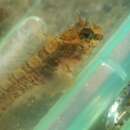Diseases and Parasites
(
anglais
)
fourni par Fishbase
Lymphocystis Disease. Viral diseases
- licence
- cc-by-nc
- droit d’auteur
- FishBase
- Recorder
- Kristine Elaine Paz Olisa
Life Cycle
(
anglais
)
fourni par Fishbase
Oviparous, distinct pairing (Ref. 205).
- licence
- cc-by-nc
- droit d’auteur
- FishBase
Trophic Strategy
(
anglais
)
fourni par Fishbase
Demersal spawners in nearshore habitats (Ref. 56049). Benthic in shallow littoral subtidal area, ranging from sub-littoral fringe to 20 m deep, but usually less than 10 m deep (Ref. 56052). Mostly sedentary and exhibits high non-reproductive territoriality (Ref. 2850, 56052), more territorial than H. gilberti and H. gentilis which only becomes strongly territorial when guarding their eggs; rarely wanders from its "home" tidepool, usually only less than a meter away, defending it against intrusion since burrows may be closely adjacent (15-20 cm); may passively withdraw into its hole as dar as possible when intruded by another fish or may also exhibit active defense mechanism of jawing (attacking with widely open mouth) and gular display (throat membranes expanded, head darkens, fins erect, body laterally vibrates rapidly) (Ref. 56052). Found in rocky areas (Ref. 37955), or in fouling masses on bottom of boats and floats, inhabiting holes and crevices, often in burrows of boring clams or tubes of marine worms such as Serpulorbis worm shells, and in mussel beds such as of Lithophaga and Pholadidea(Ref. 2850, 56052). Population living in pholalid holes are larger than those in vermitid tubes; body size may have evolved to match the sizes of shleters available as individuals which outgrow the size of their refuges are forced into less protective habitats exposed to higher risk of predation (Ref. 56052, 93609). Survival success increases with more crevices unoccupied by adults to protect the postlarvae from cannibalism and predation. Settling larvae and small individuals may be preyed by larger adults due to spatial competition. Predation by others is rare since this species is cryptic. Predators of Hypsoblennius include Pralabrax clathartus, Pralabrax maculatofasciatus, Heterostichus rostratus, and Scorpaenichthys marmoratus. Other fishes living in the same area include: Neoclinus stephensae, Paraclinus integripinnis, Gibbonsia elegans, Coryphopterus nicholsi, Lythrypnus dalli, L. Zebra, Oxylebius picta, Artedius corallinus, and Orthonopias (Ref. 56052).
- licence
- cc-by-nc
- droit d’auteur
- FishBase
- Recorder
- Kristine Elaine Paz Olisa
Biology
(
anglais
)
fourni par Fishbase
Adults are found in rocky areas (Ref. 37955), inhabiting holes and crevices, often in burrows of boring clams or tubes of marine worms, also in mussel beds (Ref. 2850). Mostly sedentary and territorial (Ref. 2850). Demersal spawners in nearshore habitats (Ref. 56049). Oviparous. Eggs are demersal and adhesive (Ref. 205), and are attached to the substrate via a filamentous, adhesive pad or pedestal (Ref. 94114). Larvae are planktonic, often found in shallow, coastal waters (Ref. 94114).
- licence
- cc-by-nc
- droit d’auteur
- FishBase
Hypsoblennius jenkinsi: Brief Summary
(
catalan ; valencien
)
fourni par wikipedia CA
Hypsoblennius jenkinsi és una espècie de peix de la família dels blènnids i de l'ordre dels perciformes.
- licence
- cc-by-sa-3.0
- droit d’auteur
- Autors i editors de Wikipedia
Hypsoblennius jenkinsi: Brief Summary
(
anglais
)
fourni par wikipedia EN
Hypsoblennius jenkinsi, commonly known as the mussel blenny, is a species of combtooth blenny found in the eastern-central Pacific Ocean. This species grows to a length of 13 centimetres (5.1 in) TL. The specific name honours Oliver Peebles Jenkins (1850-1935), who was professor of physiology at Stanford University.
- licence
- cc-by-sa-3.0
- droit d’auteur
- Wikipedia authors and editors
Hypsoblennius jenkinsi: Brief Summary
(
espagnol ; castillan
)
fourni par wikipedia ES
Hypsoblennius jenkinsi es una especie de pez de la familia Blenniidae en el orden de los Perciformes.
- licence
- cc-by-sa-3.0
- droit d’auteur
- Autores y editores de Wikipedia
Hypsoblennius jenkinsi
(
basque
)
fourni par wikipedia EU
(RLQ=window.RLQ||[]).push(function(){mw.log.warn("Gadget "ErrefAurrebista" was not loaded. Please migrate it to use ResourceLoader. See u003Chttps://eu.wikipedia.org/wiki/Berezi:Gadgetaku003E.");});
- licence
- cc-by-sa-3.0
- droit d’auteur
- Wikipediako egileak eta editoreak
Hypsoblennius jenkinsi: Brief Summary
(
basque
)
fourni par wikipedia EU
Hypsoblennius jenkinsi Hypsoblennius generoko animalia da. Arrainen barruko Actinopterygii klasean sailkatzen da, Blenniidae familian.
- licence
- cc-by-sa-3.0
- droit d’auteur
- Wikipediako egileak eta editoreak

